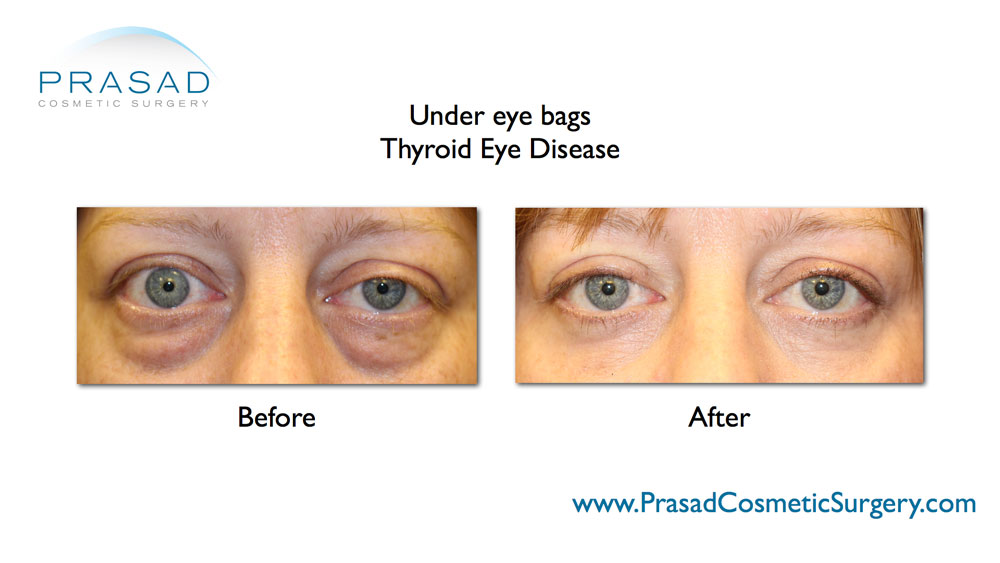Schedule Your Consultation with Dr. Prasad Here
- Home
- About Dr. Prasad
- Face & Eyes
Eyelifts
- Eyelid Surgery
- Eye lift Before and After Photos
- Asian Eyelid Surgery
- Upper Eyelid Surgery
- Upper Eyelid Hollow / Lower Brow Hollowing
- Under Eye Bag Surgery
- Eyelid Ptosis Surgery
- Transconjunctival Blepharoplasty
- Under Eye Fillers
- Eyelid Surgery Revision Specialist
- Thyroid Eye Disease
- Tear Trough Implants
- Eye Lift Questions and Answers
- Body
- Injectables
- Laser
- Hair Restoration
- Photos
- Hair Restoration Before and After Photos
- Eye lift Before and After Photos
- Upper Blepharoplasty Before and After
- Ptosis Surgery Before And After
- Facelift Before and After Photos
- Lip Enhancement Before and After Photos
- Under Eye Filler Before and After
- Blepharoplasty Before and After
- Lower Blepharoplasty Before and After Photos
- Eyelid Surgery Before and After
- Double Eyelid Surgery Before and After
- Contact Us
Thyroid Eye Disease Surgery – Graves Eye Disease Surgery
Thyroid Eye Disease Before and After










What is thyroid eye disease / Graves eye disease?
Thyroid eye disease, or thyroid-related immune orbitopathy (TRIO), is often characterized by the bulging of one or both eyes. This disease can also cause the eyelids to retract (pull away from the eyes) and also cause the eyes to become misaligned (crossed).
This condition is also known as Graves’ disease. TRIO or Graves’ disease is caused by antibodies which affect your thyroid gland and at the same time cause muscles and fat behind the eye to become inflamed and push the eyes forward.
Contrary to popular belief, the thyroid gland actually does not directly cause this inflammation of the fat and muscles around the eye. In some cases, inflammation can compress the optic nerve, causing vision loss.


How to Test for Thyroid Eye Disease?
Thyroid eye disease is an autoimmune condition of the thyroid, which is best diagnosed, and initially treated by neuro-ophthalmologist, or endocrinologist. Depending on the severity of the case, inflammation can be left to resolve on its own, or treatment can be done to reduce inflammation.
Stages of Thyroid Eye Disease
- Inflammatory stage
- Fibrotic stage
The Inflammatory Stage
The inflammatory stage is when the eyes change and appear large, push forward, and can also appear red. This is when the bulging of the eyes can cause lower eyelids to pull down (lower eyelid retraction) and upper eyelids to become too open (upper eyelid retraction). There are continuous changes to the eye during the inflammatory stage, which can last from 2-5 years.
The Fibrotic Stage
The fibrotic stage is when the disease has stabilized from the constant changes of the inflammatory stage. Stability is determined by measuring the relative position of the eye called exophthalmometry and other ophthalmic measurements.
In addition to examinations, clinical photography is done to confirm the eyes’ stability in appearance. Once stability is confirmed, surgical correction of upper and lower eyelid retraction and repositioning of the eyeball can be planned.

While this is the stage where the eyes appear their worst, surgery is not usually performed since the eyes are continuously changing. In special situations where vision is being threatened, surgery such as orbital decompression is performed.


How is Thyroid Eye Disease Treated?
Treatments administered for thyroid eye disease by a neuro-ophthalmologist or an endocrinologist include corticosteroids to suppress the immune system to reduce inflammation. Thyroid hormone levels are monitored by an endocrinologist. The thyroid hormone can be high (hyperthyroid), low (hypothyroid) or normal (euthyroid). In situations where the thyroid hormone levels are high, thyroid suppression drugs as well as radioactive iodine (RAI) can be prescribed by the endocrinologist.
As an oculoplastic surgeon, Dr. Prasad treats the damage to the eyelids caused by the inflammation after the inflammatory stage has passed on its own, or reduced by treatment from a neuro-ophthalmologist, or an endocrinologist.


For some patients, surgical correction is not necessary as the eyes and eyelids can settle into a more natural position without medical intervention.
What is orbital decompression surgery?
Orbital decompression surgery is sometimes performed during the inflammatory stage to prevent vision loss. This is due to the potential of swollen eye muscles and fat from thyroid eye disease to put pressure on the optic nerve causing vision loss.
In these circumstances, orbital decompression surgery is used to create more room in the bony area around the eye, allowing the enlarged fat and muscles to shift.
This added space reduces the pressure on the optic nerve and allows the eye to be positioned further back in the orbit.


Eyelid Retraction Repair – Upper and Lower Eyelid Blepharoplasty
Lower eyelids being pulled down, and upper eyelids being pulled upwards so the eyes are too open are common signs of thyroid-related immune orbitopathy (TRIO).


Restoration of eyelid position of upper and lower eyelids can be performed with limited surgery such as Mueller’s muscle resection and levator muscle myotomy or recession. It can also involve grafting tissue to increase the length of the retracted tissue. Procedures can involve the grafting of skin, temporalis fascia, Enduragen, hard palate graft, and decellularized dermis. Stabilization of the eyelid structure can involve procedures such as lateral canthoplasty, canthopexy and drill hole canthopexy.
Thyroid Eye Disease Surgery in New York
To better understand your options for thyroid eye disease treatment, schedule a consultation with Dr. Prasad by filling up the form below or calling any of our offices – (212) 265-8877 Manhattan, New York City or (516) 742-4636 Garden City, Long Island, New York.
